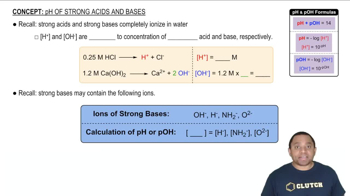Here are the essential concepts you must grasp in order to answer the question correctly.
Solubility Product Constant (Ksp)
The solubility product constant (Ksp) is an equilibrium constant that applies to the solubility of ionic compounds. It quantifies the extent to which a compound can dissolve in water, represented by the product of the molar concentrations of its ions, each raised to the power of their coefficients in the balanced equation. For calcium oxalate, Ksp = 2.3 x 10^-9 indicates that at equilibrium, the product of the concentrations of Ca2+ and C2O4^2- ions must not exceed this value for the compound to remain dissolved.
Recommended video:
Solubility Product Constant
pH and Acid-Base Equilibrium
pH is a measure of the acidity or basicity of a solution, with lower values indicating higher acidity. In the context of urine, the pH affects the ionization of weak acids like oxalic acid, which can dissociate into oxalate ions (C2O4^2-) that participate in the formation of calcium oxalate precipitate. The degree of ionization is influenced by the pH, and a lower pH (like 5.5) favors the formation of oxalate ions, potentially leading to precipitation if the ion concentrations exceed the Ksp.
Recommended video:
pH of Strong Acids and Bases
Impact of Diet on Urine pH
Diet can significantly influence urine pH, with vegetarian diets typically resulting in more alkaline urine (pH > 7). An increase in pH can affect the solubility of certain compounds; for calcium oxalate, a higher pH may reduce the concentration of oxalate ions due to decreased ionization of oxalic acid. Consequently, this could lower the likelihood of calcium oxalate precipitation, making kidney stone formation less probable in alkaline urine compared to more acidic conditions.
Recommended video:
 Verified step by step guidance
Verified step by step guidance

